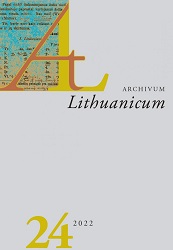Tekstas kaip gyvatvorė
Text as a Hedgerow
Author(s): Paulius V. SubačiusSubject(s): Syntax, Philosophy of Language, Philology
Published by: Lietuvių Kalbos Institutas
Keywords: Text; philology; metaphors; syntactic connectivity; criticism;
Summary/Abstract: Text, what it is and what it is like, has always been a topic of discussion in philology. In turn, the variety of description of text and the interconnected definitions of work and document have been enormous, and specifying them never ends. As we operate in abstract nouns qualifying human activity, the conceptual metaphor that we choose considerably affects the direction of thinking. The article proposes a critical overview of commonly used images of text: net, structure, fluid water, forest, garden etc., and suggests a new metaphor, ‘text as a hedgerow’. This concept differs particularly from former organicist imagination drawing on the vitality of a wild plant, in that it directs the view to the meeting point of spontaneity and reasoning, the involuntary and the planned, the natural and the acculturated or tamed. Besides the spontaneous pull towards the sun (in the case of literature, towards fame), the image of a hedgerow implies conscious grafting, orderly pruning, and planned shaping. Even more important is the tension between the function prescribed by the author, the editor or the reader, and uninhibited and unpredictable growth. The natural structures of branching out and leafing, determined by vegetative conditions that enact the tendencies of syntactic connectivity, and the tension of form imposed by the pruner, are always complicated. From a processual point of view, we can distinguish two modes of operation that are both opposite and complementary: not restricting freedom of growth and cyclically restraining to prevent exceeding imaginary boundaries. The dialectics of genres characteristic of all human activity in this respect seem to express the whole scale of the means of cultivation. The function of a hedgerow to separate, conceal and cover, as well as the possibility to peep through a gap and slip through it, is beneficial for the philological imagination. The world behind a text (the referential plane) and the behind-the-text consciousness (the intentional plane) on both sides of the textual hedgerow are separated from readers by the text so that they can cast a glance. However, if they try to get in, they are scratched and damage the hedgerow. Genetic criticism usually records only frozen phases of revision and rewriting, not to mention stills of textual changes that have remained in manuscripts. In the best case, crossed-out and inserted words help reconstruct how the pruner worked with the tools, from which side he/she started, and if the job was accomplished, and in how many stages. The article calls for ways to convey the processuality of genesis and to refresh the debate on the methodology of scholarly editing.
Journal: Archivum Lithuanicum
- Issue Year: 2022
- Issue No: 24
- Page Range: 9-26
- Page Count: 18
- Language: Lithuanian

